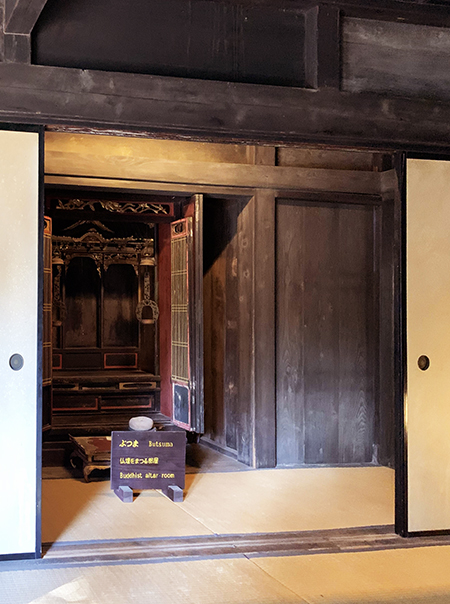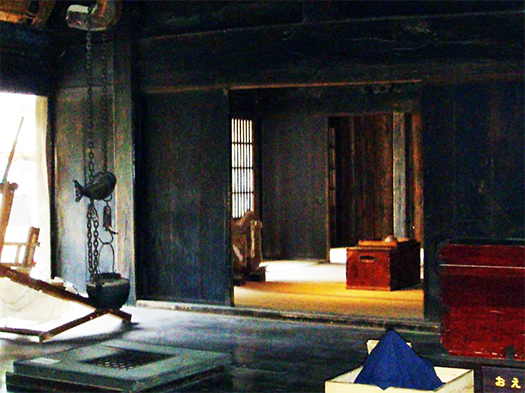

日本住宅の最近の傾向として神聖空間の空洞化、消滅がある。
核家族化が進行し「本家」意識での親戚の紐帯が縁遠くなってきている。
戦後の東京への一極集中の固定化の果てに首都周辺の住宅地に
核家族住宅としての住宅を持った世代が徐々に高齢化し、
その次の代に受け継がれて行くにつれ、いわば出身地域での地縁・血縁関係が
否応なく希薄化し始めているのだと思う。
新たに首都圏近郊で住宅を持った世代では、その帰るべき故郷の
「本家」自身も継続困難に陥ってしまい日本人の「家」意識が危機を迎えている。
経済構造が大転換して資本主義の世界競争に従属した結果、
地域の伝統的経済構造が破綻し、一方で戦後構造もより分散に向かっている。
遠くない将来、地縁血縁的な結びつきが消滅の危機になっていくのが趨勢。
現代では仏壇を持つ家は少数派であり、たとえあったとしても
その継承は難しく、家族関係の縮小化圧力で困難になりつつある。
しかしこの列島社会が発展してくるなかで
宗教が果たしてきた役割はさまざまな意味で非常に大きい。
この越中五箇山では「浄土真宗」本願寺が勢力を拡大した。
戦国期には守護大名の支配を凌駕する勢いを示し、
講を中心とした自治的な地域運営が実質支配であった故実もある。
まことに「生業」の必死さが色濃いこの家でも、突き出し的な
神聖空間「ぶつま」が、畳敷きの迎賓空間のさらに奥に端座している。
必死な生き方・機能最優先の住空間の中に最重視した空間痕跡。


すぐ上の写真で「おまえ」という迎賓空間には先日確認した「押板」もみえる。
おまえとは「御前」という書き方が想定される神聖空間の暗示。
このような配置からはこの迎賓空間自体、宗教的「寄り合い」と
深く関わっていた実態を見せているように思う。
兵農分離されていない歴史段階ではこの宗教パワーは世を覆っていた。
わたしの家系も大阪石山に籠城した本願寺顕如勢力に
毛利と連合して支援し続けていた家系伝承がある。
その集会場とみなせる神社拝殿空間もいまに残っている。
「にっくき織田を殲滅するぞ」という反政府スローガンが聞こえてくるかと(笑)。
こうした宗教勢力の台頭に強い危機感を持って「根絶やし」に動いたのが
信長の政権だったのだろう。残虐を極めたとされる殲滅戦は、
宗教という巨大なパワーに立ちはだかった武家の恐怖心を逆に表している。
そのような草の根パワーが、この家の神聖空間を彩っている。
この家の生き様、生業の痕跡とともに、
こういった宗教空間への深い思いもこだましてくるように思う。
さてわたしたち現代住宅には稀少化したこういった精神的空間は
今後とも順調に消え去っていくのだろうか。
わたし自身で言えば、末子であり仏壇はないけれど、
個人的に親の記憶装置はいくつか考えているし、全国の神社巡りでの
神札収集は今後とも継続して神棚の充実(笑)に勤めたいと思っている。
宗教と日本人住宅の関係性は、単純に消え去っていかないのではないかと。
English version⬇
[Buddhist altar between Japanese and religion / Etchu monks / Good Japanese house ⑳-4]
The post-war society is largely divided from the pre-war society, but the symbol is the religious space. Can the “head family” continue to maintain the Buddhist altar?・ ・ ・
The recent trend of Japanese housing is the hollowing out and disappearance of the sacred space.
As the nuclear family grows, the ties of relatives with a “head family” consciousness are becoming far away.
In the residential area around the capital after the end of the postwar fixation of concentration in Tokyo
The generation with housing as a nuclear family housing is gradually aging,
As it is passed down to the next generation, so to speak, the territorial and blood relations in the area of origin
I think it is inevitably beginning to dilute.
For generations who have new housing in the suburbs of the Greater Tokyo Area, their hometown
The “head family” itself has fallen into difficulty in continuing, and the Japanese “home” consciousness is in crisis.
As a result of a major transformation of the economic structure and subordination to the world competition of capitalism
The traditional economic structure of the region has collapsed, while the postwar structure is becoming more decentralized.
In the not too distant future, the trend is that kinship ties will be in danger of disappearing.
Today, there are a minority of houses with altars, even if they do.
Its inheritance is difficult and is becoming more difficult due to the pressure to shrink family relationships.
However, as this archipelago society develops
The role that religion has played is enormous in many ways.
In this Etchu Gokayama, the “Jodo Shinshu” Honganji Temple expanded its power.
During the Warring States period, it showed momentum that surpassed the rule of the guardian daimyo.
There is also the fact that autonomous regional management centered on lectures was the actual control.
Even in this house where the desperation of “living business” is really strong, it is sticky
The sacred space “Butsuma” sits further back in the tatami-matted guest space.
A space trace that emphasizes the highest priority in a living space that prioritizes desperate way of life and function.
In the guest space called “You” in the photo above, you can also see the “Oshiban” that I confirmed the other day.
You are a suggestion of a sacred space that is supposed to be written as “Gozen”.
From such an arrangement, the guest space itself is a religious “closeness”.
I think it shows the reality of being deeply involved.
This religious power overwhelmed the world in the unseparated historical stage.
My family is also a siege of Honganji Temple in Ishiyama, Osaka
There is a family folklore that has continued to support in association with Mouri.
The shrine worship space, which can be regarded as the meeting place, still remains.
I wonder if you can hear the anti-government slogan, “I’ll annihilate Nikki Oda” (laughs).
With a strong sense of crisis about the rise of these religious forces, they moved to “eradicate”.
It must have been Nobunaga’s administration. The annihilation war, which is said to have been extremely cruel,
It expresses the fear of the samurai who stood against the enormous power of religion.
Such grassroots power colors the sacred space of this house.
With the way of life of this house, the trace of living
I think that deep feelings for such a religious space also echo.
By the way, these spiritual spaces that have become rare in our modern houses
Will it disappear steadily in the future?
Speaking of myself, I am the youngest child and there is no Buddhist altar,
I personally think about some of my parents’ storage devices, and I visit shrines all over the country.
I would like to continue collecting the gods and work to enhance the Kamidana (laughs).
I think the relationship between religion and Japanese housing will simply not disappear.
Posted on 2月 1st, 2021 by 三木 奎吾
Filed under: 住宅マーケティング, 日本社会・文化研究







コメントを投稿
「※誹謗中傷や、悪意のある書き込み、営利目的などのコメントを防ぐために、投稿された全てのコメントは一時的に保留されますのでご了承ください。」
You must be logged in to post a comment.